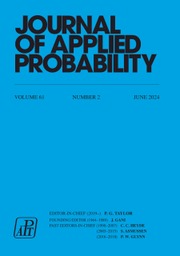Article contents
Ergodic theorem for branching markov chains indexed by trees with arbitrary shape
Published online by Cambridge University Press: 09 June 2025
Abstract
We prove an ergodic theorem for Markov chains indexed by the Ulam–Harris–Neveu tree over large subsets with arbitrary shape under two assumptions: (i) with high probability, two vertices in the large subset are far from each other, and (ii) with high probability, those two vertices have their common ancestor close to the root. The assumption on the common ancestor can be replaced by some regularity assumption on the Markov transition kernel. We verify that these assumptions are satisfied for some usual trees. Finally, with Markov chain Monte Carlo considerations in mind, we prove that when the underlying Markov chain is stationary and reversible, the Markov chain, that is the line graph, yields minimal variance for the empirical average estimator among trees with a given number of nodes. In doing so, we prove that the Hosoya–Wiener polynomial is minimized over  $[{-}1,1]$ by the line graph among trees of a given size.
$[{-}1,1]$ by the line graph among trees of a given size.
MSC classification
Information
- Type
- Original Article
- Information
- Copyright
- © The Author(s), 2025. Published by Cambridge University Press on behalf of Applied Probability Trust
References
- 1
- Cited by


